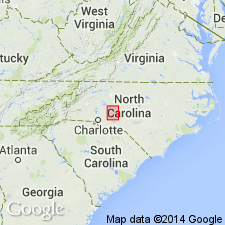
- Usage in publication:
-
- Efland Formation*
- Modifications:
-
- Named
- Dominant lithology:
-
- Tuff
- Greenstone
- Conglomerate
- Graywacke
- AAPG geologic province:
-
- Piedmont-Blue Ridge province
Summary:
Efland Formation, named in this report, described as a water-laid sequence consisting of andesitic tuffs with interbedded greenstones, conglomerates, graywackes, and flows. Includes Denny Conglomerate Member (new) in upper part at most localities in Person Co. Total thickness may be as much as 10,000 ft. Conformably overlies Uwharrie Formation (new) and grades upward into Tillery Formation of Albemarle Group (both new). Age is early Paleozoic.
Source: GNU records (USGS DDS-6; Reston GNULEX).

- Usage in publication:
-
- Efland Formation*
- Modifications:
-
- Areal extent
- AAPG geologic province:
-
- Piedmont-Blue Ridge province
Summary:
The Efland Formation is not present in Albemarle, Denton, and Mount Pleasant quads in central NC. Here the Uwharrie Formation underlies the Tillery Formation.
Source: GNU records (USGS DDS-6; Reston GNULEX).
For more information, please contact Nancy Stamm, Geologic Names Committee Secretary.
Asterisk (*) indicates published by U.S. Geological Survey authors.
"No current usage" (†) implies that a name has been abandoned or has fallen into disuse. Former usage and, if known, replacement name given in parentheses ( ).
Slash (/) indicates name conflicts with nomenclatural guidelines (CSN, 1933; ACSN, 1961, 1970; NACSN, 1983, 2005, 2021). May be explained within brackets ([ ]).

